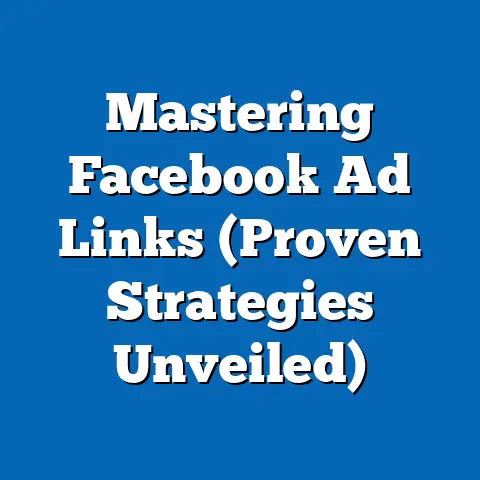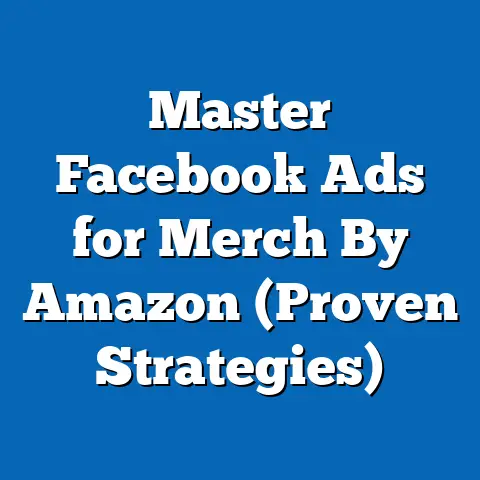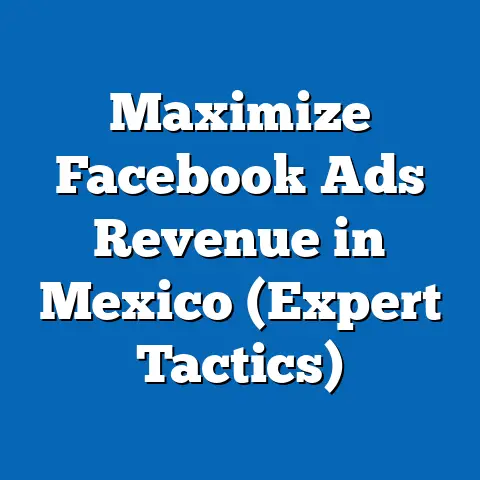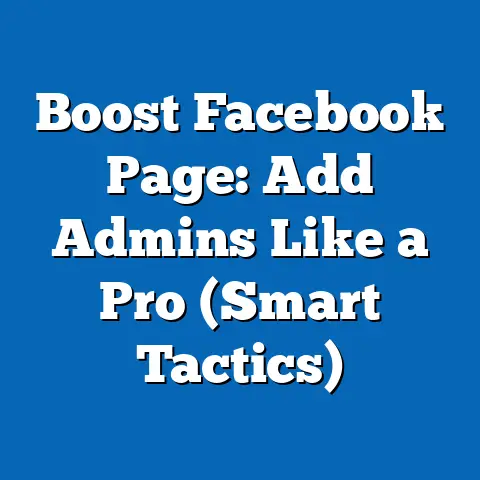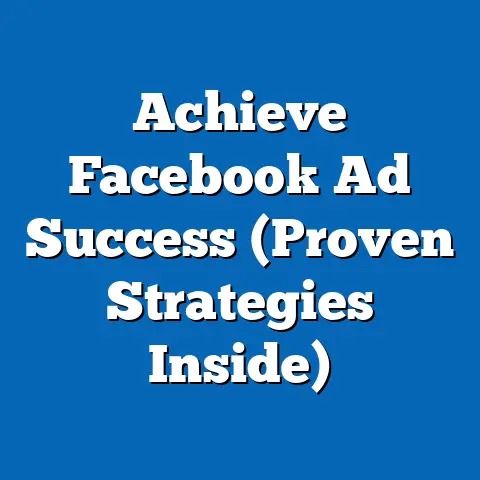Revive Facebook Ad’s Reach (Expert Strategies Unleashed)
Imagine Facebook as a bustling, vibrant marketplace. Colorful banners flutter, enticing sounds echo, and a myriad of faces pass by, each a potential customer. Your ad is a stall in this marketplace, vying for attention. But what if your stall is tucked away in a corner, unseen, unheard? That’s the reality for many Facebook advertisers struggling with dwindling reach. The good news is, with the right strategies, you can reignite the spark, bring your stall to the forefront, and watch your customer base flourish.
In the ever-evolving world of Facebook advertising, reach is the lifeblood of your campaigns. It’s the breath that fills your sails, propelling your message to the masses. Without adequate reach, even the most compelling ad copy and stunning visuals will languish in obscurity. But fear not! This guide is your treasure map to unlocking the secrets of Facebook’s algorithm and mastering the art of expanding your ad reach. Let’s dive in and explore the expert strategies that will breathe new life into your Facebook ad campaigns and ensure your message resonates with the audience it deserves.
Section 1: Understanding Facebook Ad Reach
Facebook ad reach is simply the number of unique individuals who saw your ad. It’s a fundamental metric that dictates the potential impact of your campaign. Why is it so critical? Because you can’t influence someone who doesn’t see your ad. Reach directly correlates to brand awareness, lead generation, and ultimately, sales.
It’s important to understand the distinction between organic and paid reach. Organic reach refers to the number of people who see your content without you paying for it. This primarily comes from people who follow your page and their friends. Paid reach, on the other hand, is the number of unique individuals who see your ad because you paid for it. While organic reach is valuable, it’s been steadily declining, making paid reach increasingly crucial for businesses looking to scale their impact.
Facebook’s algorithm acts as the gatekeeper, deciding which ads get shown to which users. It’s a complex beast, constantly evolving, but fundamentally, it aims to deliver the most relevant and engaging content to each individual user. Several factors influence this decision, including:
- User Engagement: Ads that generate likes, comments, shares, and clicks are favored by the algorithm.
- Relevancy Score: This score, based on user feedback, indicates how relevant your ad is to your target audience.
- Bidding Strategies: The amount you bid for your ad placement and the bidding strategy you choose (e.g., lowest cost, target cost) significantly impact your reach.
The decline in organic reach is a well-documented phenomenon. Back in 2012, organic reach for Facebook pages hovered around 16%. Today, it’s a fraction of that, often less than 2%. This shift has forced businesses of all sizes to embrace paid advertising to maintain visibility and connect with their target audience. I remember when I first started in digital marketing, relying solely on organic reach felt viable. Now, it’s almost impossible to achieve substantial results without a strategic paid advertising approach.
Takeaway: Understand the importance of reach, the difference between organic and paid, and how Facebook’s algorithm impacts ad visibility. Next step: Recognize the challenges hindering your ad reach.
Section 2: Common Challenges with Facebook Ad Reach
Even with a solid understanding of reach and the algorithm, many advertisers face significant challenges in maximizing their ad visibility. Let’s explore some common pitfalls:
- Ad Fatigue: This occurs when your target audience sees the same ad too many times, leading to decreased engagement and even negative feedback. It’s like listening to the same song on repeat – eventually, you’ll tune it out.
- Audience Saturation: If you’re targeting a very specific audience with a limited number of potential customers, you may eventually saturate that audience, meaning you’ve shown your ads to everyone who’s likely to be interested.
- Poor Targeting: Targeting the wrong audience is a surefire way to waste your ad budget and limit your reach. If your ad isn’t relevant to the people seeing it, they’re unlikely to engage.
- Changes in User Behavior: User behavior on Facebook is constantly evolving. People are spending more time on video content, engaging with Stories, and joining groups. If your ad strategy doesn’t adapt to these changes, your reach will suffer.
- Facebook’s Policy Updates: Facebook frequently updates its advertising policies, and non-compliance can lead to ad disapprovals and limited reach.
I recall working with a local bakery that was struggling with their Facebook ads. They were running the same ad showcasing their signature cake for months, targeting a broad geographic area. Initially, they saw some success, but engagement quickly plummeted. They were experiencing ad fatigue and targeting too broadly. They were essentially showing the same cake to the same people, over and over again, without tailoring their message or exploring new audiences. Their reach dwindled, and they were throwing money away.
Another challenge I’ve observed is the impact of Facebook’s algorithm updates. One client, a fashion retailer, had a highly successful ad campaign running for several months. Suddenly, their reach tanked. After investigating, we discovered that Facebook had rolled out a new algorithm update prioritizing video content. Their ads, which were primarily image-based, were no longer getting the same visibility.
Takeaway: Recognize common challenges like ad fatigue, audience saturation, and poor targeting. Next Step: Implement expert strategies to overcome these hurdles and revive your Facebook ad reach.
Section 3: Expert Strategies to Revive Facebook Ad Reach
Now, let’s get to the heart of the matter: actionable strategies to breathe new life into your Facebook ad campaigns and expand your reach.
Targeting the Right Audience
This is arguably the most critical aspect of any successful Facebook ad campaign. It’s not enough to simply target “people interested in coffee” if you’re selling gourmet coffee beans. You need to delve deeper and leverage Facebook’s powerful targeting options:
- Lookalike Audiences: This feature allows you to create audiences that resemble your existing customers or website visitors. Facebook analyzes the characteristics of your source audience (e.g., email list, website traffic) and identifies users with similar traits. This can significantly expand your reach to highly qualified prospects. I’ve seen Lookalike Audiences consistently outperform broad targeting options. For example, I once created a Lookalike Audience based on a client’s high-value customers. The resulting ad campaign generated a 3x higher conversion rate compared to their previous broad targeting efforts.
- Custom Audiences: Custom Audiences allow you to target specific groups of people based on their interactions with your business. You can upload customer lists, target website visitors, or engage with users who have interacted with your Facebook page or ads. This is incredibly effective for retargeting and nurturing leads.
- Leveraging Facebook’s Audience Insights: This tool provides valuable data about your target audience, including their demographics, interests, behaviors, and purchasing habits. Use this information to refine your targeting and create more relevant ads. For example, I recently used Audience Insights to discover that my target audience was highly engaged with specific online communities related to sustainable living. I then incorporated this information into my ad copy and targeting, resulting in a significant boost in engagement.
Creative and Engaging Content
Even with perfect targeting, your ad won’t succeed if the content is boring or irrelevant. You need to create visually appealing and engaging ads that capture attention and resonate with your target audience.
- High-Quality Visuals: Use professional-quality images and videos that are visually appealing and relevant to your product or service. Avoid stock photos that look generic and unauthentic.
- Compelling Ad Copy: Your ad copy should be clear, concise, and persuasive. Highlight the benefits of your product or service and address the needs and pain points of your target audience. Use strong calls to action that encourage users to take the desired action (e.g., “Shop Now,” “Learn More,” “Sign Up”).
- A/B Testing: Experiment with different ad creatives and copy to see what resonates best with your audience. Test different headlines, images, and calls to action to identify the winning combinations.
- Tell a Story: People connect with stories. Use your ad copy and visuals to tell a compelling story that resonates with your target audience.
One of my favorite examples of successful ad creative comes from a local coffee shop. Instead of simply showcasing their coffee beans, they created a video ad featuring a local artist using their coffee to create stunning paintings. The ad was visually captivating, told a compelling story, and highlighted the unique quality of their coffee. It went viral within the local community, significantly boosting their brand awareness and sales.
Utilizing Video Ads
Video ads are incredibly effective for increasing reach and engagement. They capture attention more effectively than static images and allow you to convey more information in a shorter amount of time.
- Keep it Short and Sweet: Aim for video ads that are 15-30 seconds long. People have short attention spans, so you need to grab their attention quickly.
- Optimize for Mobile: Most Facebook users access the platform on their mobile devices. Ensure your video ads are optimized for mobile viewing, including using vertical formats and adding captions.
- Tell a Story: Use your video ad to tell a compelling story that resonates with your target audience.
- Include a Strong Call to Action: End your video ad with a clear call to action that encourages users to take the desired action.
I’ve found that incorporating user-generated content (UGC) into video ads can be incredibly effective. UGC feels more authentic and relatable than professionally produced content. One client, a travel agency, created a video ad featuring customer-submitted videos of their recent trips. The ad was incredibly engaging and generated a significant increase in bookings.
A/B Testing and Optimization
Continuous testing and optimization are essential for maximizing your Facebook ad reach. You need to constantly experiment with different targeting options, ad creatives, and bidding strategies to discover what resonates best with your audience.
- Test One Variable at a Time: When A/B testing, only change one variable at a time so you can accurately measure the impact of that change.
- Use Facebook’s A/B Testing Tools: Facebook provides built-in A/B testing tools that make it easy to test different ad variations.
- Analyze Your Results: Carefully analyze the results of your A/B tests to identify the winning combinations.
- Implement Your Findings: Implement your findings by scaling up the winning ad variations and pausing the underperforming ones.
I always recommend starting with broad A/B tests to identify the most effective targeting options and ad creatives. Once you’ve identified the winning combinations, you can then run more granular tests to optimize specific elements of your ads.
Leveraging Facebook Pixel
The Facebook Pixel is a powerful tool that allows you to track user behavior on your website and retarget ads effectively. By placing the Pixel on your website, you can track actions such as page views, add-to-carts, and purchases. This data can then be used to create Custom Audiences and retarget ads to users who have previously interacted with your website.
- Install the Pixel on Your Website: The first step is to install the Facebook Pixel on your website.
- Track Key Events: Configure the Pixel to track key events such as page views, add-to-carts, and purchases.
- Create Custom Audiences: Use the Pixel data to create Custom Audiences of website visitors who have taken specific actions.
- Retarget Your Ads: Retarget your ads to these Custom Audiences with relevant offers and messaging.
Retargeting is one of the most effective ways to increase your Facebook ad reach and drive conversions. I’ve seen retargeting campaigns consistently outperform prospecting campaigns. For example, I recently ran a retargeting campaign for an e-commerce client targeting users who had added items to their cart but didn’t complete the purchase. The campaign generated a 20% increase in sales.
Staying Updated with Trends
The world of social media marketing is constantly evolving. New trends emerge, algorithms change, and user behavior shifts. It’s essential to stay informed about the latest trends and adapt your strategies accordingly.
- Follow Industry Blogs and Publications: Stay updated on the latest trends and best practices by following industry blogs and publications.
- Attend Industry Events: Attend industry events to network with other marketers and learn about the latest innovations.
- Experiment with New Features: Facebook is constantly rolling out new features and tools. Experiment with these features to see how they can improve your ad reach and engagement.
I make it a point to dedicate time each week to staying updated on the latest trends in social media marketing. This allows me to proactively adapt my strategies and ensure that my clients are always ahead of the curve.
Takeaway: Implement these expert strategies to target the right audience, create engaging content, leverage video ads, A/B test and optimize, utilize the Facebook Pixel, and stay updated with trends. Next step: Analyze real-world case studies of successful Facebook ad campaigns.
Section 4: Case Studies of Success
Let’s examine a few real-world examples of brands that successfully revived their Facebook ad reach using the strategies we’ve discussed.
- Local Restaurant: A local restaurant was struggling with low foot traffic. They implemented a Facebook ad campaign targeting local residents with enticing photos of their menu items and a special discount for first-time customers. They also created a Lookalike Audience based on their existing customer base. As a result, they saw a 30% increase in foot traffic and a significant boost in sales.
- E-commerce Store: An e-commerce store was experiencing high cart abandonment rates. They implemented a retargeting campaign targeting users who had added items to their cart but didn’t complete the purchase. They offered a small discount and free shipping to incentivize them to complete their purchase. This resulted in a 20% reduction in cart abandonment rates and a significant increase in sales.
- Non-Profit Organization: A non-profit organization was struggling to raise awareness for their cause. They created a compelling video ad featuring stories of people who had been helped by their organization. They targeted a broad audience with interests related to their cause. The video ad went viral, generating a significant increase in donations and volunteers.
These case studies highlight the power of strategic Facebook advertising. By implementing the right strategies, businesses of all sizes can revive their ad reach and achieve their marketing goals. I have personally seen these strategies work wonders for businesses across various industries. The key is to be patient, persistent, and willing to experiment.
Takeaway: Study these case studies and identify strategies that can be applied to your own Facebook ad campaigns. Next step: Wrap up the article and reiterate the importance of maintaining an impactful Facebook ad presence.
Conclusion
In today’s competitive digital landscape, maintaining an impactful Facebook ad presence is more crucial than ever. The platform is constantly evolving, and algorithms are always changing, but the fundamental principles of effective advertising remain the same: target the right audience, create engaging content, and continuously test and optimize your campaigns.
Don’t be discouraged if you’re currently struggling with low ad reach. By adopting a proactive approach and implementing the strategies shared in this article, you can revive your Facebook ad campaigns and achieve your marketing goals. Experiment with different targeting options, ad creatives, and bidding strategies to discover what resonates best with your audience. Stay informed about the latest trends and adapt your strategies accordingly.
Remember, Facebook advertising is an ongoing process of learning and optimization. Don’t be afraid to experiment, make mistakes, and learn from your failures. With persistence and dedication, you can master the art of Facebook advertising and unlock the full potential of this powerful platform. Now, go forth and revive your Facebook ad reach!


